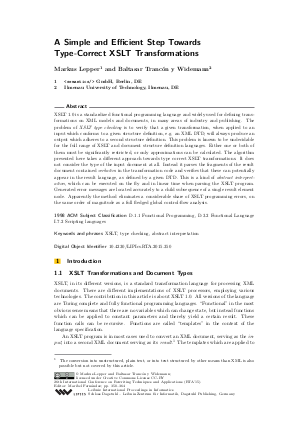A Simple and Efficient Step Towards Type-Correct XSLT Transformations
Authors Markus Lepper, Baltasar Trancón y Widemann
-
Part of:
Volume:
26th International Conference on Rewriting Techniques and Applications (RTA 2015)
Part of: Series: Leibniz International Proceedings in Informatics (LIPIcs)
Part of: Conference: International Conference on Rewriting Techniques and Applications (RTA) - License:
 Creative Commons Attribution 3.0 Unported license
Creative Commons Attribution 3.0 Unported license
- Publication Date: 2015-06-18
File

PDF
LIPIcs.RTA.2015.350.pdf
- Filesize: 0.58 MB
- 15 pages
Document Identifiers
Subject Classification
Keywords
- XSLT
- type checking
- abstract interpretation
Metrics
- Access Statistics
-
Total Accesses (updated on a weekly basis)
0PDF Downloads0Metadata Views
Abstract
XSLT 1.0 is a standardized functional programming language and widely used for defining transformations on XML models and documents, in many areas of industry and publishing. The problem of XSLT type checking is to verify that a given transformation, when applied to an input which conforms to a given structure definition, e.g. an XML DTD, will always produce an output which adheres to a second structure definition. This problem is known to be undecidable for the full range of XSLT and document structure definition languages. Either one or both of them must be significantly restricted, or only approximations can be calculated. The algorithm presented here takes a different approach towards type correct XSLT transformations. It does not consider the type of the input document at all. Instead it parses the fragments of the result document contained verbatim in the transformation code and verifies that these can potentially appear in the result language, as defined by a given DTD. This is a kind of abstract interpretation, which can be executed on the fly and in linear time when parsing the XSLT program. Generated error messages are located accurately to a child subsequence of a single result element node. Apparently the method eliminates a considerable share of XSLT programming errors, on the same order of magnitude as a full fledged global control-flow analysis.
Cite As Get BibTex
Markus Lepper and Baltasar Trancón y Widemann. A Simple and Efficient Step Towards Type-Correct XSLT Transformations. In 26th International Conference on Rewriting Techniques and Applications (RTA 2015). Leibniz International Proceedings in Informatics (LIPIcs), Volume 36, pp. 350-364, Schloss Dagstuhl – Leibniz-Zentrum für Informatik (2015)
https://doi.org/10.4230/LIPIcs.RTA.2015.350
BibTex
@InProceedings{lepper_et_al:LIPIcs.RTA.2015.350,
author = {Lepper, Markus and Tranc\'{o}n y Widemann, Baltasar},
title = {{A Simple and Efficient Step Towards Type-Correct XSLT Transformations}},
booktitle = {26th International Conference on Rewriting Techniques and Applications (RTA 2015)},
pages = {350--364},
series = {Leibniz International Proceedings in Informatics (LIPIcs)},
ISBN = {978-3-939897-85-9},
ISSN = {1868-8969},
year = {2015},
volume = {36},
editor = {Fern\'{a}ndez, Maribel},
publisher = {Schloss Dagstuhl -- Leibniz-Zentrum f{\"u}r Informatik},
address = {Dagstuhl, Germany},
URL = {https://drops.dagstuhl.de/entities/document/10.4230/LIPIcs.RTA.2015.350},
URN = {urn:nbn:de:0030-drops-52078},
doi = {10.4230/LIPIcs.RTA.2015.350},
annote = {Keywords: XSLT, type checking, abstract interpretation}
}
